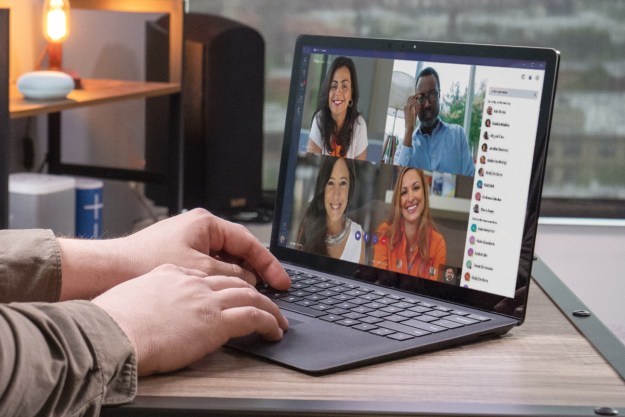Google Meet is Google’s videoconferencing service, which allows for up to 100 individuals to chat at a time (or up to 250 individuals on select business plans). The best part about the service is that it is free to use, and all video meetings are encrypted in transit to help prevent anyone from snooping in on your conversations. Follow this guide to learn exactly how to use Google Meet and get started connecting to your friends, family, and co-workers.
Start a Google Meet video meeting

If you are starting the Google Meet conference, you can follow these steps to get started. Note, you will need a Google account or G Suite account to begin. If you are using a G Suite business account, your administrator must enable the service before you can start using it. At this time, Google Meet supports the Chrome web browser, as well as Mozilla Firefox, Microsoft Edge, and Apple Safari. Additionally, Google Meet can be used on iOS and Android devices.
Mac or PC
If you are on a Mac or Windows PC, you can follow these instructions to start a Google Meet video meeting. Be sure to use one of the compatible web browsers, as mentioned above.
Step 1: Visit the Google Meet website.
Step 2: Click either Join or Start a Meeting.
Step 3: If prompted, enter a meeting nickname (for G Suite users).
Step 4: Click the Join Now button.
To invite individuals to your Google Meet video meeting, you can click the Meeting Details button in the lower-left corner. Then copy the link and share it with anyone you wish to join. Alternatively, you can click the Add People button (shown as a person with a plus symbol) in the top-right corner, then select Invite and enter the person’s email address.
Android or iOS
If you are using a mobile device running Android or iOS, you can follow these instructions to start a Google Meet video meeting. Before beginning, make sure you download the official Google Meet app from either the
Step 1: Open the Meet app.
Step 2: Tap the New Meeting button (shown as a plus symbol).
Step 3: If prompted, enter a meeting nickname (for G Suite users).
Step 4: Tap Join Meeting.
To invite individuals to your Google Meet video meeting, tap the Info button (i), then select the Share option. Choose how you wish to share the meeting information with your friends, family, or co-workers.
Joining a Google Meet video meeting

There are quite a few different ways that you can join a Google Meet video meeting. We will be reviewing the most popular options, including from inside Gmail, from Google Calendar, using a meeting link URL, and using a telephone. Follow the steps below based on how you wish to join a Google Meet video meeting.
From Gmail

Step 1: Visit the Gmail website.
Step 2: On the left side, click Join a Meeting.
Step 3: Enter the meeting code or nickname you received.
Step 4: Click the Join button.
One improvement Google has made to the Gmail process is creating a dedicated Meet tab on the Gmail app for mobile devices. If you’re on a mobile device, you can now navigate to the Meet section to check meet invites and join meetings without needing to open a new app or tab. This also makes it very easy to accept invitations.
From Google Calendar
Step 1: Open your Google calendar.
Step 2: Locate the event and click on it.
Step 3: Select the Join with Google Meet option.
Step 4: Click, Join Now.
From a meeting link (URL)
Step 1: Locate the meeting link URL sent to you.
Step 2: Click on the Google Meet URL.
Step 3: Wait for approval to be admitted to the meeting if required.
From a telephone
Step 1: Locate the phone number provided for your Google Meet.
Step 2: Dial the phone number on your telephone.
Step 3: When prompted, enter the PIN provided, tap the # button.
Settings to alter during a meeting

Google allows you to alter certain settings during a Google Meet video call, such as the layout, provided captions, and control over your microphone and camera. These are the most common actions.

Change meeting view
Step 1: While on a PC or Mac, click the More button (three vertical dots), then click Change Layout.
Step 2: Here you can select from a collection of views — automatic, tiled, spotlight, and sidebar.
Step 3: Once you choose a layout, it will be saved for the next time you use Meet.
Viewing closed captions
On a PC, Mac, Android, or iOS device, click the [CC] captions button to turn on or off English captions; this button may be hidden under the More button (three vertical dots) section.
Present high-quality video
Meet can also show high-quality video with included audio content during a meeting. This includes YouTube videos, GIFs, animations, and other media you may need to use as guides, examples, or tutorials. However, it only works via Chrome, so you’ll need to be using the Chrome browser when trying this.
Step 1: To begin, while in a meeting, select the Present now button and choose Chrome tab from the list of options.
Step 2: Meet will then display the open Chrome tabs you have to choose from. It’s a good idea to have a Chrome tab prepared with your video or other media beforehand for this moment. Select the right tab, make sure the Share audio option is enabled, and select Share.
Step 3: You can now play the video in the tab and everyone will be able to see and hear it.

Send a chat message
Step 1: On a PC, Mac, Android, or iOS device, click the Chat button (sometimes shown as a tiny text bubble).
Step 2: Enter the message you wish to send to the room, and click the Send button (shown as a small paper airplane).
Present your screen
Step 1: On a PC, Mac, Android, or iOS device, click the More button (three vertical dots), then click the Present Screen option and click Start Broadcast to begin.
Step 2: To stop presenting, return to Google Meet, and click Stop Broadcast.
Record a meeting
Step 1: On a PC or Mac, click the More button (three vertical dots), then click Record Meeting.
Step 2: To stop, repeat the steps, and click Stop Recording.
Step 3: Note that participants will be notified when anyone begins recording the meeting. Additionally, the video recording will be saved to your Google Drive for later retrieval.
Turn noise cancellation on
Step 1: Meet can use A.I. to filter out sounds that aren’t voices. You can turn this feature on by selecting the three-dot Settings menu, choosing Audio, and enabling Noise cancellation.
Step 2: This should not affect any other voices, including radio voices and people in the same room.
Stop your webcam or mute your microphone
Step 1: On a PC, Mac, Android, or iOS device, click the round microphone button to mute or unmute your microphone.
Step 2: Similarly, click the round camera icon (shown as a box with a triangle on the right side) to turn on or turn off your webcam.
Latest specialized Meet features

Google has been applying lots of updates and new features to Meet in 2020, many specifically designed to make teacher/classroom conferences easier. Features worth checking out and practicing with include:
Jamboard
Jamboard is a digital whiteboard that allows attendees to draw, scribble, and annotate in a versatile space. The Jamboard can be viewed and used by all members of the meeting, but for classroom sessions, the teacher can restrict it to themselves or whoever is the current presenter. It’s also designed to be used as a brainstorming tool!
Breakout rooms
One important feature that Meet was previously missing was the ability to sort into breakout rooms, or divide a current group into smaller digital sessions where they can talk and work together. This is a very important feature for both businesses and classrooms, and is now available on Meet with an excellent interface and great management options. Google also intends to add timers and an “ask for help” button to give teachers even more options when in breakout mode.
Attendance reports
G Suite Enterprise for Education customers now have access to easy attendance reports as well. These are automatically generated reports created in Google Sheets, and show the names and email of everyone present in the meeting, including information on when they joined, when they left, and how long they were there. Google will also be adding the ability for teachers to enable or disable this feature as needed.

Q&A sessions
Q&A Mode is a new optional Education feature that benefits teachers and students. The advanced chat lets students ask their teacher questions during a lesson. The teacher can choose whether or not to use the feature and can hide questions from the group that may seem inappropriate or off-subject.
Polling tool
The polling tool is a new feature that we anticipate will get a more significant rollout soon. Teachers can use it to insert a quick, live quiz in the middle of a lesson in order to test student’s comprehension levels and provide immediate feedback for educators.
Is Zoom better than Google Meet?
Zoom and Google Meet are neck-and-neck in most competitions. The video conferencing tools are similar, with the most distinguishable feature being their cost. Currently, Google Meet is 100% free for up to 100 participants for meetings up to 60 minutes. Zoom offers free virtual meetings for up to 100 people, but for only 40 minutes. For teams who prefer to get in and get out, this won’t be an issue. But most teams will find themselves needing to purchase a monthly or yearly subscription to extend meeting times. On top of that, Zoom has previously faced some privacy issues, making some feel more comfortable trusting their video conferencing to Google. You can check out Google’s Meet security measures here.
Editors' Recommendations
- This new Google Sheets feature is going to save so much time
- Intel’s new Thunderbolt feature ‘fundamentally changes’ how you use two PCs
- Donald Glover is making a movie with Google’s new video AI
- Best refurbished laptop deals: How to find cheap used computers
- The best resume templates for Google Docs



